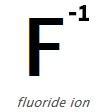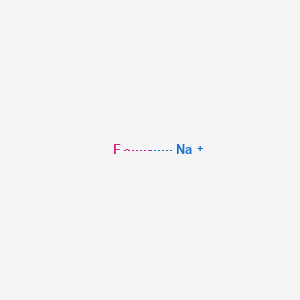SECTION 1. IDENTIFICATION
Product Name: Sodium Fluoride
Product Number: All applicable American Elements product codes, e.g. NA-F-02
, NA-F-03
, NA-F-04
, NA-F-05
CAS #: 7681-49-4
Relevant identified uses of the substance: Scientific research and development
Supplier details:
American Elements
10884 Weyburn Ave.
Los Angeles, CA 90024
Tel: +1 310-208-0551
Fax: +1 310-208-0351
Emergency telephone number:
Domestic, North America: +1 800-424-9300
International: +1 703-527-3887
SECTION 2. HAZARDS IDENTIFICATION
2.1. CLASSIFICATION OF THE SUBSTANCE OR MIXTURE
Class 6.1 Poison. Poisonous by ingestion. Dust extremely irritating to eyes. Ingestion causes nausea, vomiting, stomach pains and diarrhoea. Particular care must be exercised when machining and creating dust or particles. Lethal dose about 4g.
2.2. LABEL ELEMENTS
Signal Word: Warning
H301 Toxic if swallowed
H315 Causes skin irritation
H319 Causes serious eye irritation
Precautionary Statements:
P262 Do not breathe dust/fume/gas/mist/vapors/spray.
P264 Wash thoroughly after handling.
P270 Do not eat, drink or smoke when handling this product
P301+P310 IF SWALLOWED: Immediately call a poison centre or doctor. Rinse mouth.
P302 +P352 IF ON SKIN: Wash with plenty of soap and water
P303+P351+P338 IF IN EYES: Rinse cautiously with water for several minutes. Remove contact lenses, if present and easy to do. Continue rinsing.
2.3. OTHER HAZARDS
None
SECTION 3. COMPOSITION/INFORMATION ON INGREDIENTS
3.1. SUBSTANCES
Component Name CAS number % EC number (EINECS) EU index UN number
Sodium Fluoride 7681-49-4 100% 231-667-8 009-004-00-7 1690
SECTION 4. FIRST AID MEASURES
4.1. DESCRIPTION OF FIRST AID MEASURES
GENERAL: Consult a doctor for specific advice.
EYES: Irrigate thoroughly with water for at least 15 minutes. Obtain medical attention.
SKIN: Wash thoroughly with soap and water. Dry area with clean towel. Remove contaminated clothing and wash clothing before re-use.
INHALATION: Remove to fresh air. Perform artificial respiration if breathing has stopped. When breathing is difficult, properly trained personnel may administer oxygen. Keep affected person warm and at rest. Obtain medical attention.
INGESTION: Induce vomiting if conscious and as directed by properly qualified personnel. Wash out mouth thoroughly with water. Do not give carbonated drinks. Never give anything by mouth to an unconscious person. Obtain medical attention immediately.
4.2. MOST IMPORTANT SYMPTOMS AND EFFECTS, BOTH ACUTE AND DELAYED
Refer to Section 2.2 and to section 11.
4.3. INDICATION OF ANY IMMEDIATE MEDICAL ATTENTION AND SPECIAL TREATMENT NEEDED
No Data.
SECTION 5. FIREFIGHTING MEASURES
5.1. EXTINGUISHING MEDIA
This product does not burn.
5.2. SPECIAL HAZARDS ARISING FROM THE SUBSTANCE OR MIXTURE
Material may evolve toxic fumes in a fire.
5.3. ADVICE FOR FIREFIGHTERS
None.
SECTION 6. ACCIDENTAL RELEASE MEASURES
6.1. PERSONAL PRECAUTIONS, PROTECTIVE EQUIPMENT AND EMERGENCY PROCEDURES
Wear suitable protective clothing & equipment as listed under Section 8. Avoid making dust.
6.2. ENVIRONMENTAL PRECAUTIONS
Prevent further leakage or spillage. Do not let product enter drains. Do not discharge to the environment.
6.3. METHODS AND MATERIALS FOR CONTAINMENT AND CLEANING UP
Take up and containerize for proper disposal. Containerize any cleaning materials used for proper disposal.
6.4. REFERENCE TO OTHER SECTIONS
Dispose as in Section 13.
SECTION 7. HANDLING AND STORAGE
7.1. PRECAUTIONS FOR SAFE HANDLING:
Keep away from heat. Avoid contact with skin and eyes. Protect against physical damage. Avoid generating dust.
7.2. CONDITIONS FOR SAFE STORAGE, INCLUDING ANY INCOMPATIBILITIES
Keep away from foodstuffs. Keep away from acids and strong bases.
7.3. SPECIFIC END USES
Optical Material for Manufacture of Optical Components.
SECTION 8. EXPOSURE CONTROLS/PERSONAL PROTECTION
8.1. CONTROL PARAMETERS
OCCUPATIONAL EXPOSURE LIMITS (OEL) = 2.5 mg/m3 as Fluoride in 8 hour Time Weighted Average (TWA)
8.2. EXPOSURE CONTROLS
Protective gloves made of PVA are required. Use of a laboratory coat is suggested. Safety goggles or safety glasses with side shields are required if there is any possibility of chipping or dust creation. Respirators must be worn when the threshold limit is exceeded. Provide adequate general mechanical ventilation, and local exhaust ventilation. Wash hands immediately after handling the product.
SECTION 9. PHYSICAL AND CHEMICAL PROPERTIES
9.1. INFORMATION ON BASIC PHYSICAL AND CHEMICAL PROPERTIES
APPEARANCE : Clear glassy geometric shapes, no odour. FLASH POINT: Not Applicable
BOILING POINT (760mm Hg) 1700C FLAMMABILITY: Not Applicable
MELTING POINT: 993C EXPLOSIVE PROPERTIES: Not Applicable
SPECIFIC GRAVITY: 2.85 g/mL Vapor PRESSURE: Not Applicable
SOLUBILITY IN WATER: Slightly; 4.22g/100ml H2O at 18C pH IN AQUEOUS SOLUTION: No data available
9.2. OTHER SAFETY INFORMATION
None
SECTION 10. STABILITY AND REACTIVITY
10.1. REACTIVITY
Reacts with strong mineral acids and strong oxidising materials
10.2. CHEMICAL STABILITY
Stable under normal conditions of storage and use
10.3. POSSIBILITY OF HAZARDOUS REACTIONS
None known
10.4. CONDITIONS TO AVOID
Reacts with oxidising agents. Avoid strong acids, particularly hot conc. Sulphuric Acid
10.5. INCOMPATIBLE MATERIALS
Strong Mineral Acids. Strong oxidising materials
10.6. HAZARDOUS DECOMPOSITION PRODUCTS
Decomposition product is Hydrogen Fluoride gas in contact with mineral acid.
SECTION 11. TOXICOLOGICAL INFORMATION
11.1. INFORMATION ON TOXICOLOGICAL EFFECTS
Harmful in contact with skin. Particular care must be exercised when machining and creating dust or particles.
TOXIC DOSE - LD50 > 52 mg/kg (oral, rat)
CARCINOGENICITY: Some evidence of carcinogenic properties in animals.
MUTAGENICITY/TERATOGENICITY: Evidence of reproductive effects.
SECTION 12. ECOLOGICAL INFORMATION
12.1. TOXICITY
Hazard to drinking water.
12.2. PERSISTENCE AND DEGRADABILITY
No Data
12.3. BIOACCUMULATIVE POTENTIAL
No Data
12.4. MOBILITY IN SOIL
No Data
12.5. RESULTS OF PBT AND vPvB ASSESSMENT
Not required or conducted
12.6. OTHER ADVERSE AFFECTS
The following applies to inorganic fluorides in general: biological effects: fish: L idus LC50 660mg/l; bacteria:Ps putida toxic from 231 mg/l up; algae: Sc quadricauda toxic from 249mg/l up; protozoa:E.sulcatum toxic from 101mg/l up; U parduczi toxic from 71mg/l up (all values as NaF).
SECTION 13. DISPOSAL CONSIDERATIONS
Chemical residues are generally classified as special waste, and are covered by regulations which vary according to location. Contact your local waste disposal authority for advice, or pass to a chemical disposal company.
SECTION 14. TRANSPORT INFORMATION
14.1. UN NUMBER: 1690
14.2. UN PROPER SHIPPING NAME:
Sodium Fluoride Solid.
14.3. TRANSPORT HAZARD CLASS: 6.1
14.4. PACKING GROUP: III
14.5. ENVIRONMENTAL HAZARDS: No Data
14.6. SPECIAL PRECAUTIONS FOR USER: None
14.7. TRANSPORT IN BULK MARPOL / IBC: No Data
SECTION 15. REGULATORY INFORMATION
15.1. SAFETY, HEALTH AND ENVIRONMENTAL REGULATIONS / LEGISLATION SPECIFIC FOR THE SUBSTANCE OR MIXTURE
None
SECTION 16. OTHER INFORMATION
Safety Data Sheet according to Regulation (EC) No. 1907/2006 (REACH). The above information is believed to be correct but does not purport to be all inclusive and shall be used only as a guide. The information in this document is based on the present state of our knowledge and is applicable to the product with regard to appropriate safety precautions. It does not represent any guarantee of the properties of the product. American Elements shall not be held liable for any damage resulting from handling or from contact with the above product. See reverse side of invoice or packing slip for additional terms and conditions of sale. COPYRIGHT 1997-2022 AMERICAN ELEMENTS. LICENSED GRANTED TO MAKE UNLIMITED PAPER COPIES FOR INTERNAL USE ONLY.

 See more Sodium products.
See more Sodium products.
